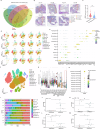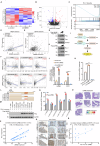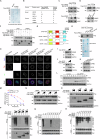LMNB2-mediated high PD-L1 transcription triggers the immune escape of hepatocellular carcinoma
- PMID: 40483310
- PMCID: PMC12145441
- DOI: 10.1038/s41420-025-02540-7
LMNB2-mediated high PD-L1 transcription triggers the immune escape of hepatocellular carcinoma
Abstract
While immune checkpoint inhibitors targeting programmed cell death-ligand 1 (PD-L1) demonstrate clinical efficacy in hepatocellular carcinoma (HCC), tumor cells frequently evade immune surveillance through PD-L1 overexpression, a phenomenon whose regulatory mechanisms remain poorly understood. Through integrated analysis of single-cell transcription sequence data, we identified aberrant upregulation of Lamin B2 (LMNB2) specifically in immunotherapy-sensitive HCC patients. Functional characterization revealed that LMNB2 acts as a transcriptional regulator of PD-L1, potentiating immune escape mechanisms in HCC cells during co-culture with Jurkat cells. Notably, we discovered that speckle-type POZ protein (SPOP) directly interacts with LMNB2 to mediate its ubiquitination and proteasomal degradation, thereby maintaining physiological PD-L1 expression levels. Clinically relevant SPOP mutations or reduced SPOP expression impaired this regulatory mechanism, leading to LMNB2 accumulation and subsequent PD-L1 hyperactivation. Importantly, combinatorial targeting of LMNB2 with Atezolizumab (PD-L1 inhibitor) displayed a synergistic effect on suppressing tumor progression both in vitro and in vivo, particularly in HCC models with SPOP mutations or LMNB2 overexpression. These findings unveil a novel ubiquitination-dependent regulatory axis in HCC immune evasion and propose targeted co-inhibition strategies to overcome HCC immunotherapy resistance.
© 2025. The Author(s).
Conflict of interest statement
Competing interests: The authors declare no competing interests. Ethics: All methods of this study were performed in accordance with relevant guidelines and regulations. All human samples involved in this study were reviewed and approved by the Ethics Committee of Ningbo University (NBU-2024-313). Animal studies were reviewed and approved by the Animal Ethics Committee of the Laboratory Animal Center of Ningbo University (AEWC-NBU20240311).
Figures







Similar articles
-
BCLAF1 binds SPOP to stabilize PD-L1 and promotes the development and immune escape of hepatocellular carcinoma.Cell Mol Life Sci. 2024 Feb 10;81(1):82. doi: 10.1007/s00018-024-05144-z. Cell Mol Life Sci. 2024. PMID: 38340178 Free PMC article.
-
SPOP mutations promote tumor immune escape in endometrial cancer via the IRF1-PD-L1 axis.Cell Death Differ. 2023 Feb;30(2):475-487. doi: 10.1038/s41418-022-01097-7. Epub 2022 Dec 8. Cell Death Differ. 2023. PMID: 36481790 Free PMC article.
-
Cyclin D-CDK4 kinase destabilizes PD-L1 via cullin 3-SPOP to control cancer immune surveillance.Nature. 2018 Jan 4;553(7686):91-95. doi: 10.1038/nature25015. Epub 2017 Nov 16. Nature. 2018. PMID: 29160310 Free PMC article.
-
PD-1/PD-L1 checkpoint inhibitors in advanced hepatocellular carcinoma immunotherapy.Front Immunol. 2022 Dec 19;13:1070961. doi: 10.3389/fimmu.2022.1070961. eCollection 2022. Front Immunol. 2022. PMID: 36601120 Free PMC article. Review.
-
Programmed death receptor (PD-)1/PD-ligand (L)1 in urological cancers : the "all-around warrior" in immunotherapy.Mol Cancer. 2024 Sep 2;23(1):183. doi: 10.1186/s12943-024-02095-8. Mol Cancer. 2024. PMID: 39223527 Free PMC article. Review.
References
-
- Bray F, Laversanne M, Sung H, Ferlay J, Siegel RL, Soerjomataram I, et al. Global cancer statistics 2022: GLOBOCAN estimates of incidence and mortality worldwide for 36 cancers in 185 countries. CA Cancer J Clin. 2024;74:229–63. - PubMed
LinkOut - more resources
Full Text Sources
Research Materials

